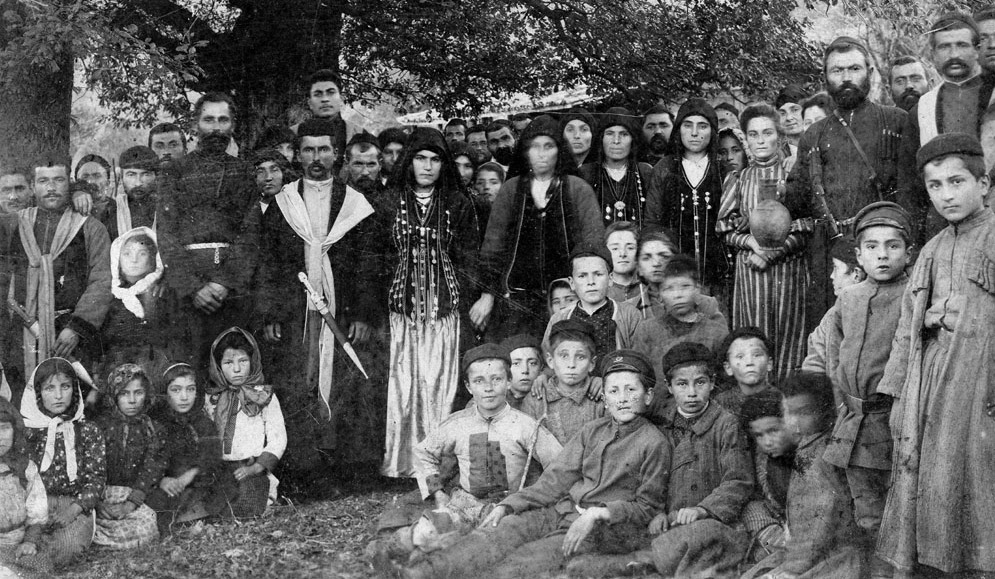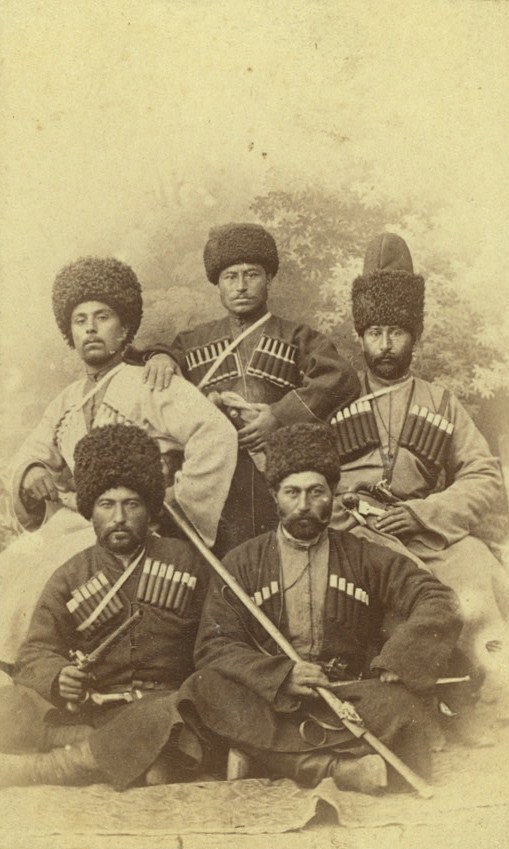|
Tushetians
The Tushetians , or Tush , are a subgroup of Georgians who mainly live in Tusheti. Tsova Tushetians speak the Tsova Tushetian language and Chagma Tushetians speak the Chagma Tushetian dialect of Georgian. Subgroups The Tush divide themselves into two groups, the Chagma-Tush, who speak the local Georgian dialect and the Tsova-Tush, also known as Bats or Batsbi, who speak the Bats language, a Nakh language. Most Bats also speak Georgian, to which there is a continuing trend of linguistic assimilation. Despite differences in language and culture (to a degree), both Chagma- and Tsova-Tush consider themselves to be part of the larger group of Tush, which in turn is considered a subgroup of Georgians. Appearance Anthropologically Tushetians have an Eastern Georgian type of face, with light colored eyes and hair color ranging from blonde to brown. Culture Traditionally, the Tushs are sheep herders. Tushetian Guda cheese (Not to be confused with European Gouda cheese, with which it ... [...More Info...] [...Related Items...] OR: [Wikipedia] [Google] [Baidu] |
Tushetians (Merzbacher, 1901)
The Tushetians , or Tush , are a subgroup of Georgians who mainly live in Tusheti. Tsova Tushetians speak the Tsova Tushetian language and Chagma Tushetians speak the Chagma Tushetian dialect of Georgian. Subgroups The Tush divide themselves into two groups, the Chagma-Tush, who speak the local Georgian dialect and the Tsova-Tush, also known as Bats or Batsbi, who speak the Bats language, a Nakh language. Most Bats also speak Georgian, to which there is a continuing trend of linguistic assimilation. Despite differences in language and culture (to a degree), both Chagma- and Tsova-Tush consider themselves to be part of the larger group of Tush, which in turn is considered a subgroup of Georgians. Appearance Anthropologically Tushetians have an Eastern Georgian type of face, with light colored eyes and hair color ranging from blonde to brown. Culture Traditionally, the Tushs are sheep herders. Tushetian Guda cheese (Not to be confused with European Gouda cheese, with which it s ... [...More Info...] [...Related Items...] OR: [Wikipedia] [Google] [Baidu] |
Bats Language
Bats (also Batsi, Batsbi, Batsb, Batsaw, Tsova-Tush) is the endangered language of the Bats people, a North Caucasian minority group and is part of the Nakh family of Northeast Caucasian languages. It had 2,500 to 3,000 speakers in 1975. There is only one dialect. It exists only as a spoken language, as Bats people use Georgian as their written language. The language is not mutually intelligible with either Chechen or Ingush, the other two members of the Nakh family. History Tusheti, the northeastern mountainous region of Georgia, is home to four tribes that consider themselves Tushetians: the Batsbi - also known as Tsovatush; the Gometsari; the Piriqiti; and the Chagma-Tush. Tsovatush people make up 50% of Tushetians. As of today only several hundred Tsovatush people speak ''Batsbur Mott – (Bats language), whereas the other tribes (Gometsari, Piriqiti and Chagma-Tush) have lost the language. Evidence from toponymics indicates that the other three Tushetian tribes formerly ... [...More Info...] [...Related Items...] OR: [Wikipedia] [Google] [Baidu] |
Omalo Ethnographic Museum
Omalo Ethnographic Museum is an ethnographic museum in village Zemo (Upper) Omalo in Tusheti region, Georgia. Tushetian Ethnographic Museum of Keselo, in Omalo preserves traditional items used by the Tusheti people, such as agricultural tools, household items and weapons. Museum exhibition is dedicated to traditions and customs and reflects the way Tushetians used to live in the past. Exhibition also includes archeological finding, such as Bronze Age axes and jewelry. Tourist trail also includes Keselo fortress. Agency of Protected Areas. See also * * |
Tusheti
Tusheti ( ka, თუშეთი) is a historic region in northeast Georgia. Geography Located on the northern slopes of the Greater Caucasus Mountains, Tusheti is bordered by the Russian republics of Chechnya and Dagestan to the north and east, respectively; and by the Georgian historic provinces Kakheti and Pshav-Khevsureti to the south and west, respectively. The population of the area is mainly ethnic Georgians called Tushs or Tushetians ( ka, tushebi). Historically, Tusheti comprised four mountain communities: the Tsova (living in the Tsova Gorge), the Gometsari (living along the banks of the Tushetis Alazani River), the Pirikiti (living along the banks of the Pirikitis Alazani River) and the Chaghma, living close to the confluence of the two rivers). Administratively speaking, Tusheti is now part of the ''raioni'' of Akhmeta, itself part of Georgia's eastern region of Kakheti. The largest village in Tusheti is Omalo. History The area is thought to have long been inhabi ... [...More Info...] [...Related Items...] OR: [Wikipedia] [Google] [Baidu] |
Bats People
The Bats people ( ka, ბაცი, tr) or the Batsbi (ბაცბი), are Nakh-speaking Tushetians in the country of Georgia. They are also known as the Ts’ova-Tush (წოვათუშები) after the Ts’ova Gorge in the historic Georgian mountain region of Tusheti. The group should not be confused with the neighbouring Kists – also a Nakh-speaking people who live in the nearby Pankisi Gorge. Language and customs Part of the community still retains its own Bats language ("batsbur mott"), which has adopted many Georgian loan-words and grammatical rules and is mutually unintelligible with the two other Nakh languages, Chechen and Ingush. As Professor Johanna Nichols put it, "he Batsburlanguage is related to Chechen and Ingush roughly as Czech is related to Russian nd the Batsbinot belong to vai naakh nor their language to vai mott, though any speaker of Chechen or Ingush can immediately tell that the language is closely related and can understand some phrases of ... [...More Info...] [...Related Items...] OR: [Wikipedia] [Google] [Baidu] |
Batsbi
The Bats people ( ka, ბაცი, tr) or the Batsbi (ბაცბი), are Nakh-speaking Tushetians in the country of Georgia. They are also known as the Ts’ova-Tush (წოვათუშები) after the Ts’ova Gorge in the historic Georgian mountain region of Tusheti. The group should not be confused with the neighbouring Kists – also a Nakh-speaking people who live in the nearby Pankisi Gorge. Language and customs Part of the community still retains its own Bats language ("batsbur mott"), which has adopted many Georgian loan-words and grammatical rules and is mutually unintelligible with the two other Nakh languages, Chechen and Ingush. As Professor Johanna Nichols put it, " he Batsburlanguage is related to Chechen and Ingush roughly as Czech is related to Russian nd the Batsbinot belong to vai naakh nor their language to vai mott, though any speaker of Chechen or Ingush can immediately tell that the language is closely related and can understand some phrases of ... [...More Info...] [...Related Items...] OR: [Wikipedia] [Google] [Baidu] |
Nakh Peoples
The Nakh peoples, also known as ''Vainakh peoples'' (Chechen/Ingush: , apparently derived from Chechen , Ingush "our people"; also Chechen-Ingush), are a group of Caucasian peoples identified by their use of the Nakh languages and other cultural similarities. These are chiefly the ethnic Chechen (including the Chechen sub-ethnos, the Kists, in Georgia), Ingush and Bats peoples of the North Caucasus, including closely related minor or historical groups. The ethnonym "Nakhchi" Nakh peoples and Vainakh peoples are two terms that were coined by Soviet ethnographers such as the Ingush ethnographer Zaurbek Malsagov. The reasoning behind the creation of these terms was to unite the closely related nations of Chechen and Ingush into one term. The terms "Vainakh" (our people) and "Nakh" (people) were first used as a term to unite two peoples in 1928. It was subsequently popularized by other Soviet authors, poets, and historians such as Mamakaev and Volkova in their research. Accor ... [...More Info...] [...Related Items...] OR: [Wikipedia] [Google] [Baidu] |
Georgians
The Georgians, or Kartvelians (; ka, ქართველები, tr, ), are a nation and indigenous Caucasian ethnic group native to Georgia and the South Caucasus. Georgian diaspora communities are also present throughout Russia, Turkey, Greece, Iran, Ukraine, United States, and European Union. Georgians arose from Colchian and Iberian civilizations of classical antiquity; Colchis was interconnected with the Hellenic world, whereas Iberia was influenced by the Achaemenid Empire until Alexander the Great conquered it. In the 4th century, the Georgians became one of the first to embrace Christianity and now the majority of Georgians are Orthodox Christians, with most following their national autocephalous Georgian Orthodox Church, although there are small Georgian Catholic and Muslim communities as well as a significant number of irreligious Georgians. Located in the Caucasus, on the continental crossroads of Europe and Asia, the High Middle Ages saw Georgian people fo ... [...More Info...] [...Related Items...] OR: [Wikipedia] [Google] [Baidu] |
Sheep
Sheep or domestic sheep (''Ovis aries'') are domesticated, ruminant mammals typically kept as livestock. Although the term ''sheep'' can apply to other species in the genus '' Ovis'', in everyday usage it almost always refers to domesticated sheep. Like all ruminants, sheep are members of the order Artiodactyla, the even-toed ungulates. Numbering a little over one billion, domestic sheep are also the most numerous species of sheep. An adult female is referred to as a ''ewe'' (), an intact male as a ''ram'', occasionally a ''tup'', a castrated male as a ''wether'', and a young sheep as a ''lamb''. Sheep are most likely descended from the wild mouflon of Europe and Asia, with Iran being a geographic envelope of the domestication center. One of the earliest animals to be domesticated for agricultural purposes, sheep are raised for fleeces, meat (lamb, hogget or mutton) and milk. A sheep's wool is the most widely used animal fiber, and is usually harvested by shearing. In Comm ... [...More Info...] [...Related Items...] OR: [Wikipedia] [Google] [Baidu] |
Shepherds
A shepherd or sheepherder is a person who tends, herds, feeds, or guards flocks of sheep. ''Shepherd'' derives from Old English ''sceaphierde (''sceap'' 'sheep' + ''hierde'' 'herder'). ''Shepherding is one of the world's oldest occupations, it exists in all parts of the globe, and it is an important part of pastoralist animal husbandry. Because of the ubiquity of the profession, many religions and cultures have symbolic or metaphorical references to the shepherd profession. For example, Jesus called himself the Good Shepherd, and ancient Greek mythologies highlighted shepherds such as Endymion and Daphnis. This symbolism and shepherds as characters are at the center of pastoral literature and art. Origins Shepherding is among the oldest occupations, beginning some 5,000 years ago in Asia Minor. Sheep were kept for their milk, meat and especially their wool. Over the next thousand years, sheep and shepherding spread throughout Eurasia. Henri Fleisch tentatively suggested ... [...More Info...] [...Related Items...] OR: [Wikipedia] [Google] [Baidu] |
Nakh Language
The Nakh languages are a group of languages within Northeast Caucasian family, spoken chiefly by the Chechens and Ingush in the North Caucasus. Bats is the endangered language of the Bats people, an ethnic minority in Georgia. The Chechen, Ingush and Bats peoples are also grouped under the ethno-linguistic umbrella of Nakh peoples. Classification The Nakh languages were historically classified as an independent North-Central Caucasian family, but are now recognized as a branch of the Northeast Caucasian family. The separation of Nakh from common Northeast Caucasian has been tentatively dated to the Neolithic (ca. 4th millennium BC). The Nakh language family consists of: * Vainakh languages, a dialect continuum with two literary languages: ** Chechen – approximately 1,330,000 speakers (2002). ** Ingush – approximately 413,000 speakers (2002). * Bats or Batsbi – approximately 3,420 (2000), spoken mostly in Zemo-Alvani, Georgia. Not mutually intelligible with Chechen ... [...More Info...] [...Related Items...] OR: [Wikipedia] [Google] [Baidu] |
.jpg)
.jpg)


.jpg)

